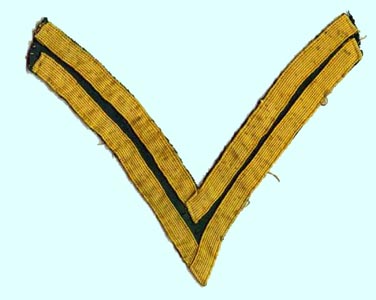
Cavalry Corporal 1855-1872 | 
Infantry Corporal 1851-1872 |
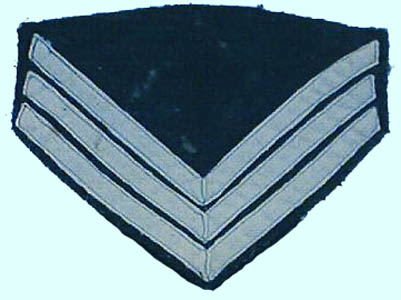
Infantry Sergeant
1851-1872 (1)
The chevron is an ancient heraldic symbol of honor. They were first used for U.S. Army noncommissioned officers in 1821. The chevrons used during different periods are fairly specific in appearance and not at all difficult to recognize. The background colors of blue, olive drab or green match the uniform worn during the period. Early chevrons indicated both grade and the branch of service. More modern ones only the grade. The titles given to the different grades and the number of grades change over time. Comparing the chevrons of different periods illustrates the evolution the evolution of insignia. I am not showing all of the chevrons worn in each period only a few examples to show their typical appearance.

Cavalry Corporal 1855-1872 | 
Infantry Corporal 1851-1872 |

The corporal chevron is made of yellow (cavalry branch color) lace on blue wool (uniform's color). Civil War chevrons are also made of worsted wool and silk. Artillery wore scarlet and infantry light blue. Only small numbers of men were in other supporting branches and I have discussed the complicated story of which colors they wore in another site's page.
 Cavalry Company Quartermaster 1872-1882 1898-1902 | 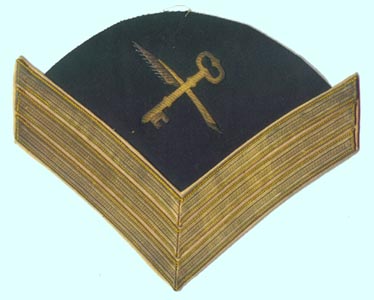 Post Quartermaster Sergeant Bullion for Dress Uniform 1884-1902 |
 Artillery Chief Trumpeter 1873-1902 | 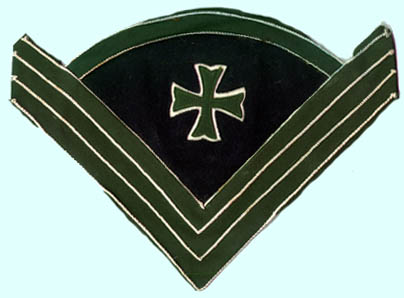 Hospital Steward 1901-1902 |
Nineteenth Century chevrons were worn point down. In the smoky, black powder environment of the 19th-Century battlefield chevrons needed to be large so they could be seen. In 1902 chevrons were redesigned and worn point up. With smokeless powder and accurate firearms smaller chevrons were necessary to avoid making noncommissioned officers targets.
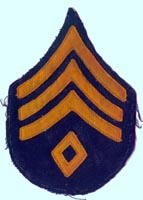 First Sergeant U.S.M.A. Detachment 1902-1918 | 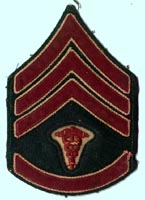 Sergeant 1st Class Hospital Corps 1902-1909 | 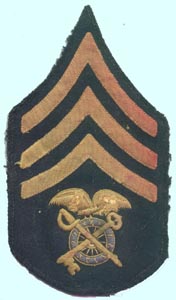 Sergeant Quartermaster Corps 1902-1918 |
There were an even larger number of different chevrons worn after 1902. These chevrons were specific to the uniform they were worn on. In the 19th Century the color of the Army's uniform and the chevron's background was blue. During the Spanish-American War the first khaki uniforms were worn and with the Regulations of 1902 the Army adopted field uniforms in khaki for summer and olive drab for winter. Each uniform had a chevron in its background color. The chevrons worn on the blue uniform indicated both the grade and branch of the wearer with the branch color. Those worn on field uniforms were underwent various modifications, but basically were made in khaki, tan or olive drab colors. White chevrons were also made for uniforms worn in tropical climates. The original regulations called for the chevrons on field uniforms to be in branch colors, but the dyes did not stand up well to cleaning and on December 31, 1904 olive drab was adopted for the stripes and arcs of the chevron. The 1902 type chevrons are among the most colorful and appealing of the chevrons used by the United States Army. In the above examples maroon and white are the colors of the medical corps and buff of the quartermaster corps.
 Sergeant First Class Quartermaster Corps 1913-1918 |  Sergeant Ordnance Corps 1917-1918 | 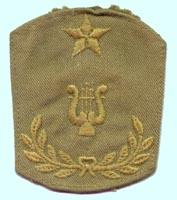 Band Leader 1918-1920 |
The chevrons used during the period of the First World War are in the olive drab color, the same as the period's uniform. The large number of different chevrons was a major headache for the quartermaster. These in fact were a continuation of the 1902 type chevrons, but the blue uniform with its branch colored stripes was suspended for the duration of the war and not reestablished until many years afterwards.
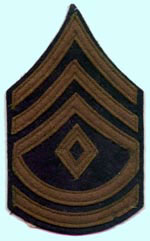 First Sergeant 1920-1942 | 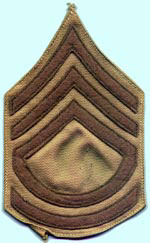 Technical Sergeant 1920-1948 | 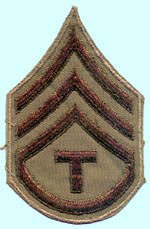 Technician 3rd Class 1942-1948 | 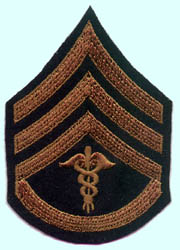 Medical Corps Staff Sergeant Private Purchase c.1940s |
In 1920 Congress reformed the grades of noncommissioned officers and created seven different grades. In keeping with this reorganization the Army removed branch and specialty distinctions from the design of chevrons. It was also decided that chevrons would not be issued with different background colors for different uniform colors, but this did not persist in practice. By the time of World War Two khaki chevrons were back. The result was a more simple and rational system of distinctions. Even so privately manufactured chevrons with branch symbols in the center were still in limited use. With the expansion of the Army at the beginning of the Second World War, a large number of individuals with special skills, but no military experience were enlisted from the civilian population. In an effort to recognize these abilities and at the same time not offend veteran noncommissioned officers, the technical grades were added in 1942.
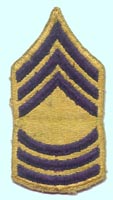 Master Sergeant (Combat) 1948-1951 | 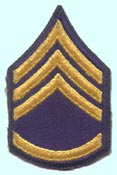 Sergeant (Noncombat) 1948-1951 |
During the period 1948-1951 the Army experimented with two-inch chevrons, originally as an economy measure. Combat units wore gold on blue and noncombat units wore blue on gold. With a reorganization of pay grades sergeants were given a chevron with three straps and an arc ("rocker") and during the period 1948-1958 the familiar three-stripe sergeant chevron was obsolete. In 1958 with another reorganization it was brought back. The smaller chevrons were never very popular and in 1951 larger chevrons that were about three inches across replaced them for the most part. The small sized chevrons continued to be worn on field jackets and by female personnel after 1951.
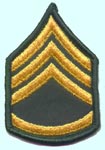 Sergeant First Class (Female) 1959-current | 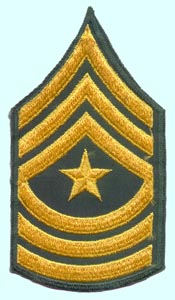 Sergeant Major 1955-current | 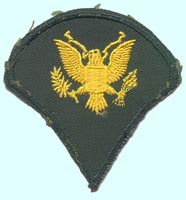 Specialist Four 1955-current |
With the introduction of the Army Green Uniform chevrons were changed in color to yellow on green. The Green uniform was phased in over many years and the first manufacture of yellow on green dates from 1955.
The various dates and titles of chevrons as shown above are simplified. The exact title of a chevron might change with reorganizations. For example, what I show as a Sergeant First Class Hospital Corps was called a Hospital Steward during the period 1902-1903. Similarly the dates shown might be more variable when considering wearing out periods, during which some to the obsolete items were still issued, etc.
This page is shared between two different sites that I maintain. To return to the particular site that you were in click on the links below.